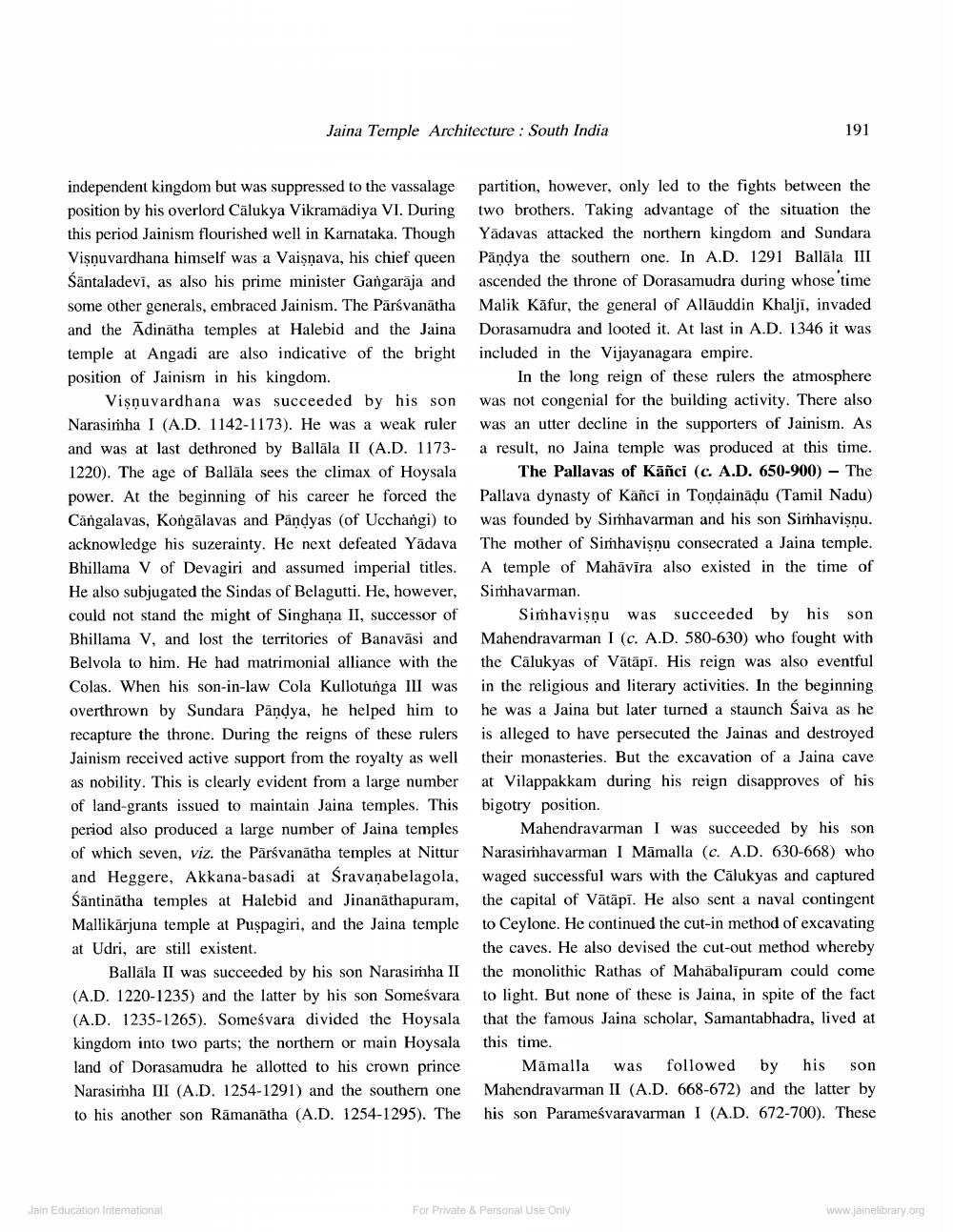________________
Jaina Temple Architecture: South India
independent kingdom but was suppressed to the vassalage position by his overlord Calukya Vikramadiya VI. During this period Jainism flourished well in Karnataka. Though Visnuvardhana himself was a Vaisnava, his chief queen Śāntaladevi, as also his prime minister Gangaraja and some other generals, embraced Jainism. The Parsvanatha and the Adinatha temples at Halebid and the Jaina temple at Angadi are also indicative of the bright position of Jainism in his kingdom.
Viṣṇuvardhana was succeeded by his son Narasimha I (A.D. 1142-1173). He was a weak ruler and was at last dethroned by Ballala II (A.D. 11731220). The age of Ballala sees the climax of Hoysala power. At the beginning of his career he forced the Cangalavas, Kongälavas and Pandyas (of Ucchangi) to acknowledge his suzerainty. He next defeated Yadava Bhillama V of Devagiri and assumed imperial titles. He also subjugated the Sindas of Belagutti. He, however, could not stand the might of Singhaṇa II, successor of Bhillama V, and lost the territories of Banavāsi and Belvola to him. He had matrimonial alliance with the Colas. When his son-in-law Cola Kullotunga III was overthrown by Sundara Pandya, he helped him to recapture the throne. During the reigns of these rulers Jainism received active support from the royalty as well as nobility. This is clearly evident from a large number of land-grants issued to maintain Jaina temples. This period also produced a large number of Jaina temples of which seven, viz. the Parsvanatha temples at Nittur and Heggere, Akkana-basadi at Śravanabelagola, Śantinātha temples at Halebid and Jinanathapuram, Mallikarjuna temple at Puspagiri, and the Jaina temple at Udri, are still existent.
Ballala II was succeeded by his son Narasimha II (A.D. 1220-1235) and the latter by his son Someśvara (A.D. 1235-1265). Someśvara divided the Hoysala kingdom into two parts; the northern or main Hoysala land of Dorasamudra he allotted to his crown prince Narasimha III (A.D. 1254-1291) and the southern one to his another son Ramanatha (A.D. 1254-1295). The
Jain Education International
191
partition, however, only led to the fights between the two brothers. Taking advantage of the situation the Yadavas attacked the northern kingdom and Sundara Pandya the southern one. In A.D. 1291 Ballāla III ascended the throne of Dorasamudra during whose 'time Malik Kafur, the general of Allauddin Khalji, invaded Dorasamudra and looted it. At last in A.D. 1346 it was included in the Vijayanagara empire.
In the long reign of these rulers the atmosphere was not congenial for the building activity. There also was an utter decline in the supporters of Jainism. As a result, no Jaina temple was produced at this time.
The Pallavas of Kañci (c. A.D. 650-900) - The Pallava dynasty of Kañcī in Toṇḍaināḍu (Tamil Nadu) was founded by Simhavarman and his son Simhaviṣṇu. The mother of Simhaviṣṇu consecrated a Jaina temple. A temple of Mahāvīra also existed in the time of Simhavarman.
Simhaviṣṇu was succeeded by his son Mahendravarman I (c. A.D. 580-630) who fought with the Calukyas of Vätäpi. His reign was also eventful in the religious and literary activities. In the beginning he was a Jaina but later turned a staunch Śaiva as he is alleged to have persecuted the Jainas and destroyed their monasteries. But the excavation of a Jaina cave at Vilappakkam during his reign disapproves of his bigotry position.
Mahendravarman I was succeeded by his son Narasimhavarman I Mamalla (c. A.D. 630-668) who waged successful wars with the Calukyas and captured the capital of Vātāpī. He also sent a naval contingent to Ceylone. He continued the cut-in method of excavating the caves. He also devised the cut-out method whereby the monolithic Rathas of Mahabalipuram could come to light. But none of these is Jaina, in spite of the fact that the famous Jaina scholar, Samantabhadra, lived at this time.
Mamalla was followed by his son Mahendravarman II (A.D. 668-672) and the latter by his son Parameśvaravarman I (A.D. 672-700). These
For Private & Personal Use Only
www.jainelibrary.org




